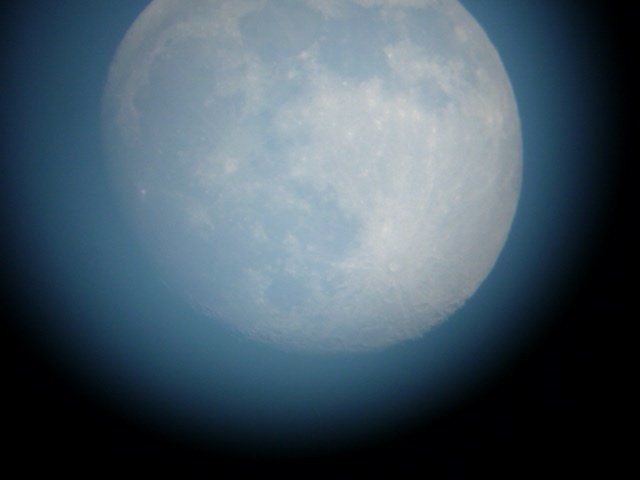
Avove photo: Buddy Puckhaper in Charleston, South Carolina, contributed the image at top of a daytime moon.
The April full moon lit up the nighttime for the last few nights, shining pretty much from dusk till dawn. Around April 20, 2019, you’ll find the moon waning in phase, and no longer out first thing at nightfall. For the mainland United States, the moon on April 20 rises in the east roughly 1 1/2 hours after sunset. And the moon will set in the west roughly 1 1/2 hours after sunrise April 21. Thus the mornings of April 21, 22 and 23, after sunrise, present the perfect time to catch a daytime moon over your western horizon after sunrise. Woot!
View the moon in your eastern sky before going to bed this week. It’ll be ascending in the east roughly an hour later each evening. Then look for the moon low in your western sky right after sunrise. Day by day, the lighted portion of the waning gibbous moon will shrink. The half-lit last quarter moon will come on April 26, 2019.
The moon is up in the daytime much of the time. But, because it’s pale against the blue sky, it’s not as noticeable as the moon at night. However, there are certain times of the month when the daytime moon is more noticeable, and the coming week presents one of those times.

You’ll often miss the moon during the day because it’s so pale against the blue daytime sky. Look closely this week, especially in the hours after sunrise. Look west! You’ll see it. Our friend Jenney Disimon in Sabah, North Borneo, caught this daytime moon on January 4, 2018.
Why is the daytime moon most noticeable now? The moon is up during the day half the time. It must be, since it orbits around the whole Earth once a month. A crescent moon is hard to see, though, because it’s so near the sun in the sky. At the vicinity of last quarter moon about a week from now, you might have to crane your neck, looking up, to notice it after sunrise.
This week’s moon is noticeable simply because the moon is still showing us most of its lighted face; it appears large in our sky. Also, in the hours after sunrise, the moon is fairly near the western horizon, so people driving to work or school might catch sight of it.
At mid-northern latitudes in North America, the moon will set about 1 1/2 hours after sunrise on April 21. It’ll set roughly one hour later after sunrise each day thereafter.
These recommended almanacs can help you find the moon’s setting time in your sky
Bottom line: The moon is now in a waning gibbous phase. Beginning Sunday morning, shortly after sunrise, you’ll see it floating pale and beautiful against a blue sky. Look west!
Donate: Your support means the world to us
from EarthSky http://bit.ly/2GoBVOD

Avove photo: Buddy Puckhaper in Charleston, South Carolina, contributed the image at top of a daytime moon.
The April full moon lit up the nighttime for the last few nights, shining pretty much from dusk till dawn. Around April 20, 2019, you’ll find the moon waning in phase, and no longer out first thing at nightfall. For the mainland United States, the moon on April 20 rises in the east roughly 1 1/2 hours after sunset. And the moon will set in the west roughly 1 1/2 hours after sunrise April 21. Thus the mornings of April 21, 22 and 23, after sunrise, present the perfect time to catch a daytime moon over your western horizon after sunrise. Woot!
View the moon in your eastern sky before going to bed this week. It’ll be ascending in the east roughly an hour later each evening. Then look for the moon low in your western sky right after sunrise. Day by day, the lighted portion of the waning gibbous moon will shrink. The half-lit last quarter moon will come on April 26, 2019.
The moon is up in the daytime much of the time. But, because it’s pale against the blue sky, it’s not as noticeable as the moon at night. However, there are certain times of the month when the daytime moon is more noticeable, and the coming week presents one of those times.

You’ll often miss the moon during the day because it’s so pale against the blue daytime sky. Look closely this week, especially in the hours after sunrise. Look west! You’ll see it. Our friend Jenney Disimon in Sabah, North Borneo, caught this daytime moon on January 4, 2018.
Why is the daytime moon most noticeable now? The moon is up during the day half the time. It must be, since it orbits around the whole Earth once a month. A crescent moon is hard to see, though, because it’s so near the sun in the sky. At the vicinity of last quarter moon about a week from now, you might have to crane your neck, looking up, to notice it after sunrise.
This week’s moon is noticeable simply because the moon is still showing us most of its lighted face; it appears large in our sky. Also, in the hours after sunrise, the moon is fairly near the western horizon, so people driving to work or school might catch sight of it.
At mid-northern latitudes in North America, the moon will set about 1 1/2 hours after sunrise on April 21. It’ll set roughly one hour later after sunrise each day thereafter.
These recommended almanacs can help you find the moon’s setting time in your sky
Bottom line: The moon is now in a waning gibbous phase. Beginning Sunday morning, shortly after sunrise, you’ll see it floating pale and beautiful against a blue sky. Look west!
Donate: Your support means the world to us
from EarthSky http://bit.ly/2GoBVOD


Aucun commentaire:
Enregistrer un commentaire